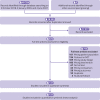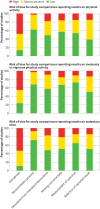Effectiveness of physical activity monitors in adults: systematic review and meta-analysis
- PMID: 35082116
- PMCID: PMC8791066
- DOI: 10.1136/bmj-2021-068047
Effectiveness of physical activity monitors in adults: systematic review and meta-analysis
Abstract
Objective: To estimate the effectiveness of physical activity monitor (PAM) based interventions among adults and explore reasons for the heterogeneity.
Design: Systematic review and meta-analysis.
Study selection: The electronic databases MEDLINE, Embase, SPORTDiscus, CINAHL, and the Cochrane Central Register of Controlled Trials (CENTRAL) were searched on 4 June 2021. Eligible randomised controlled trials compared interventions in which adults received feedback from PAMs with control interventions in which no feedback was provided. No restrictions on type of outcome measurement, publication date, or language were applied.
Data extraction and synthesis: Two reviewers independently extracted data and assessed risk of bias. Random effects meta-analyses were used to synthesise the results. The certainty of evidence was rated by the Grading of Recommendations Assessment and Evaluation (GRADE) approach.
Main outcome measures: The three primary outcomes of interest were physical activity, moderate to vigorous physical activity, and sedentary time.
Results: 121 randomised controlled trials with 141 study comparisons, including 16 743 participants, were included. The PAM based interventions showed a moderate effect (standardised mean difference 0.42, 95% confidence interval 0.28 to 0.55) on physical activity, equivalent to 1235 daily steps; a small effect (0.23, 0.16 to 0.30) on moderate to vigorous physical activity, equivalent to 48.5 weekly minutes; and a small insignificant effect (-0.12, -0.25 to 0.01) on sedentary time, equal to 9.9 daily minutes. All outcomes favoured the PAM interventions.
Conclusions: The certainty of evidence was low for the effect of PAM based interventions on physical activity and moderate for moderate to vigorous physical activity and sedentary time. PAM based interventions are safe and effectively increase physical activity and moderate to vigorous physical activity. The effect on physical activity and moderate to vigorous physical activity is well established but might be overestimated owing to publication bias.
Study registration: PROSPERO CRD42018102719.
© Author(s) (or their employer(s)) 2019. Re-use permitted under CC BY-NC. No commercial re-use. See rights and permissions. Published by BMJ.
Conflict of interest statement
Competing interests: All authors have completed the ICMJE uniform disclosure form at www.icmje.org/disclosure-of-interest/ and declare: support from the European Union’s Horizon 2020 research and innovation programme for the submitted work; no financial relationships with any organisations that might have an interest in the submitted work in the previous three years; no other relationships or activities that could appear to have influenced the submitted work.
Figures



References
-
- Lee IM, Shiroma EJ, Lobelo F, Puska P, Blair SN, Katzmarzyk PT, Lancet Physical Activity Series Working Group . Effect of physical inactivity on major non-communicable diseases worldwide: an analysis of burden of disease and life expectancy. Lancet 2012;380:219-29. 10.1016/S0140-6736(12)61031-9 - DOI - PMC - PubMed
-
- World Health Organization. WHO guidelines on physical activity and sedentary behaviour. 2020. https://apps.who.int/iris/handle/10665/336656 - PubMed
-
- Stunkard A. A Method of Studying Physical Activity in Man. Am J Clin Nutr 1960;8:595-601. 10.1093/ajcn/8.5.595 - DOI
Publication types
MeSH terms
LinkOut - more resources
Full Text Sources
Medical
Miscellaneous
